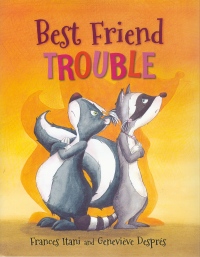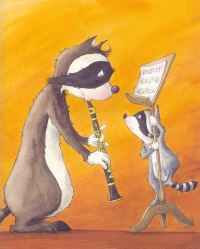| ________________
CM . . .
. Volume XX Number 21. . . .January 31, 2014 
 |
Best Friend Trouble.
Frances Itani. Illustrated by Geneviève Després.
Victoria, BC: Orca, 2014.
32 pp., hc., pdf & epub, $19.95 (hc.).
ISBN 978-1-55469-891-2 (hc.), ISBN 978-1-55469-892-9 (pdf), ISBN 978-1-4598-0714-3 (epub).
Preschool-grade 1 / Ages 3-6.
Review by Gregory Bryan and Carly Russell.
*** /4
Reviewed from f&gs.
|
| |
|

excerpt:
“What’s up?” he said. “I thought you were playing with Lizzy in the yard.”
“Lizzy!” said Hanna. “Ha!” She sat on the workbench and sighed.
“I thought you two were friends,” said Josh.
“Not anymore,” said Hanna. “Lizzy brags. She said she could throw the ball farther than I could.”
“And did she?
“She did,” said Hanna. “But the sun was in my eyes, so it wasn’t fair. She says she can swing higher than I can too.”
“Well, can she?” asked Josh.
“No,” said Hanna. “She always starts before I have a chance to pump my feet.”
“Sounds like best friend trouble to me,” said Josh.
Although many of the best moments in our lives involve friends, they can also be the source of heartache and angst. Such is the case with Orca’s new picture book, Best Friend Trouble. Hanna and Lizzy are best friends. When Lizzy throws the ball farther, Hanna’s feelings are hurt. As it turns out, their friendship has hit a rut because of the constant competition between the two of them. Hanna goes to her brother, father, and mother to express her discontent. They all suggest different ways for Hanna to take her mind from her problems.
 For the young, target audience, Frances Itani’s text is one with which they will readily be able to relate. Children (and adults) often bicker with their best friends over seemingly trivial problems. The beauty of Itani’s story is that it is through talking things over with Lizzy that she and Hanna are able to reconcile their differences. This is an important lesson for readers to learn while they are young. Hanna comes to understand that she has also been inconsiderate towards Lizzy. By talking over their problems, they learn they both have special talents and abilities and they should celebrate and embrace these things rather than constantly be in competition with one another.
For the young, target audience, Frances Itani’s text is one with which they will readily be able to relate. Children (and adults) often bicker with their best friends over seemingly trivial problems. The beauty of Itani’s story is that it is through talking things over with Lizzy that she and Hanna are able to reconcile their differences. This is an important lesson for readers to learn while they are young. Hanna comes to understand that she has also been inconsiderate towards Lizzy. By talking over their problems, they learn they both have special talents and abilities and they should celebrate and embrace these things rather than constantly be in competition with one another.
Geneviève Després’ watercolour and pencil illustrations wonderfully complement Itani’s text. Després uses hatching and cross-hatching to add texture and interest to the artwork. The large full-colour illustrations consist predominantly of a soft but warm colour palette. The muted colours and rounded shapes add a gentle touch to the book, helping to downplay the conflict. The colour choices and Després’ character portrayals will appeal to young readers. Hanna is portrayed as a racoon while Lizzy is depicted as a skunk.
Given that readers will relate to Hanna and Lizzy’s situation and because of the quality of the writing and artwork, we recommend Best Friend Trouble as a book that will appeal to young readers. Parents and teachers will also enjoy reading this book aloud to children. The book conveys the important message of trying to see things from another’s point of view and talking through our differences of opinion.
Recommended.
Dr. Gregory Bryan is a member of the Faculty of Education at the University of Manitoba, where he teaches children’s literature classes.
Carly Russell is a teacher candidate in the Early Years stream in the Faculty of Education at the University of Manitoba.

To comment
on this title or this review, send mail to cm@umanitoba.ca.
Copyright © the Manitoba Library Association. Reproduction for personal
use is permitted only if this copyright notice is maintained. Any
other reproduction is prohibited without permission.
NEXT REVIEW |
TABLE OF CONTENTS FOR THIS ISSUE
- January 31, 2013.
AUTHORS |
TITLES |
MEDIA REVIEWS |
PROFILES |
BACK ISSUES |
SEARCH |
CMARCHIVE |
HOME |

 For the young, target audience, Frances Itani’s text is one with which they will readily be able to relate. Children (and adults) often bicker with their best friends over seemingly trivial problems. The beauty of Itani’s story is that it is through talking things over with Lizzy that she and Hanna are able to reconcile their differences. This is an important lesson for readers to learn while they are young. Hanna comes to understand that she has also been inconsiderate towards Lizzy. By talking over their problems, they learn they both have special talents and abilities and they should celebrate and embrace these things rather than constantly be in competition with one another.
For the young, target audience, Frances Itani’s text is one with which they will readily be able to relate. Children (and adults) often bicker with their best friends over seemingly trivial problems. The beauty of Itani’s story is that it is through talking things over with Lizzy that she and Hanna are able to reconcile their differences. This is an important lesson for readers to learn while they are young. Hanna comes to understand that she has also been inconsiderate towards Lizzy. By talking over their problems, they learn they both have special talents and abilities and they should celebrate and embrace these things rather than constantly be in competition with one another.